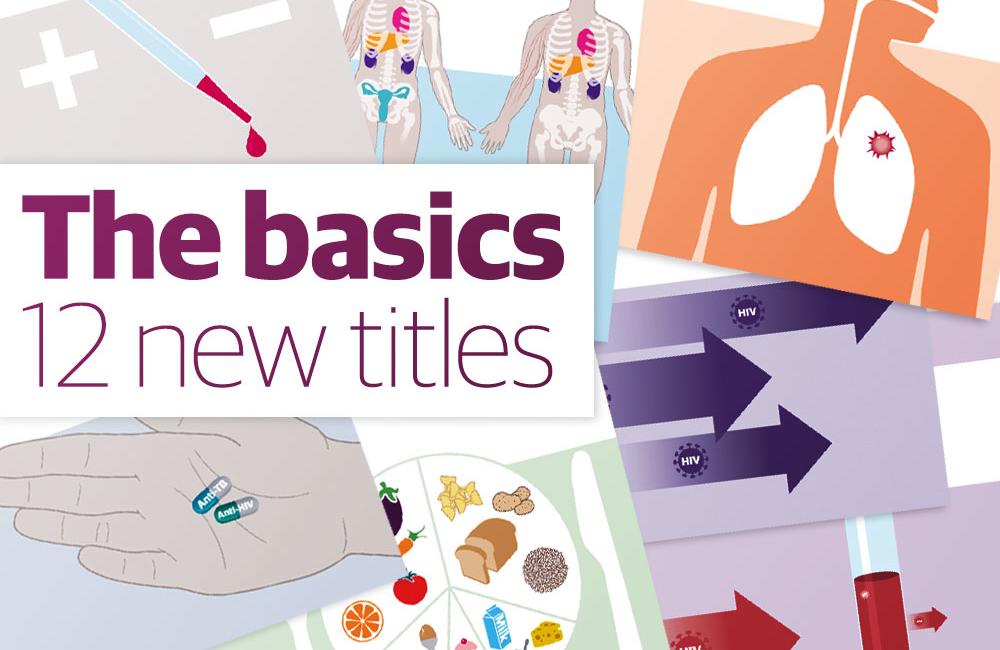
We’re really delighted to be launching 12 new titles in our popular series The basics.
The new titles are:
- Myths and facts
- Better off knowing
- Testing
- Transmission facts
- Transmission and viral load
- Transmission and the law
- Health checks
- A healthy weight
- Drug resistance
- TB and HIV
- How TB is passed on
- Treatment for TB and HIV
These expand our successful series of HIV information leaflets, which explain key health messages in a straightforward, accessible way. You can find all The basics, including the original ten titles, in the resources section of aidsmap.
The original titles have also been reviewed and updated. They were highly commended in the British Medical Association patient information awards, with the reviewer commenting, “The design is brilliant…I wouldn’t have thought so much information could be got over in such a simple and readable way…These are the best leaflets I have reviewed over the years.”
What are The basics?
These resources are unusual because they use illustrations to help break down complex health information. They are designed to support discussions between health professionals and people with HIV.
Each title covers a few key facts and the simple language and pictures bring the information to life.
Different people living with HIV have different information needs. Some people seek out information for themselves and others rely on professionals to provide them with information.
Feedback from healthcare professionals suggested there was a need for treatment education materials in a format which would be appropriate for people who do not have much prior understanding of HIV, whose first language is not English, who are less comfortable with written information, or who have lower literacy levels.
Why the new titles?
The initial ten leaflets mostly focused on topics that are fundamental for understanding HIV treatment. For example, there are leaflets on the immune system, side-effects and adherence.
While there are new leaflets on drug resistance and on the tests carried out at routine clinic appointments, the new titles have widened the focus to explain other key aspects of health and HIV.
Tuberculosis (TB) is one of the most important co-infections affecting people with HIV and there are three leaflets which make plain this complex topic. They explain why people with HIV are more vulnerable to TB, how the infections are treated and how TB is passed on.
Information about the impact of an undetectable viral load on HIV transmission is not always simply and clearly presented, so a new leaflet aims to put this right. Similarly, another leaflet explains the law on criminal HIV transmission in the most straightforward terms possible.
Feedback from HIV workers and organisations suggested that this style of leaflet could work well when working with people who are considering taking an HIV test or when raising awareness of HIV in the wider community. Therefore we have produced leaflets outlining the testing process, explaining the advantages of early diagnosis and giving basic facts on HIV transmission.
And we have also produced a small illustrated booklet (a slightly different format to the others) outlining common myths and facts about HIV. There are an enormous number of different myths out there and some of them are more relevant in some communities than others. In choosing the myths to debunk in this leaflet, our Communities Engagement Officer, Jackie Ayugi De Masi, helped us select myths that are particularly relevant to African communities in the UK, although we hope that the leaflet will be useful when working with other groups too.
We would like to thank…
We worked closely with people living with HIV and people working in HIV clinics and organisations to produce these resources.
We would like to thank everyone who generously gave their time during the original development of the format and during the development of these new titles. We presented a poster about the development of the original series to the International AIDS Conference in Vienna.
We would also like to thank the funders who supported the development of these resources, in particular the MAC AIDS Fund for supporting the new titles and the NHS Pan-London HIV Prevention Programme and NHS South West Essex for supporting the original series.
We are also grateful to Discovery for their pro-bono support in conducting qualitative research.
For more information
You can access all the titles online, or contact us to request print copies at info@nam.org.uk or 020 7837 6988.
The basics are available through our free booklet scheme, so if you work in a UK clinic or organisation, you can request free copies for use in your work.
Many of the titles have also been translated into other languages and these are also available online.
NAM has achieved certification with the Information Standard, a quality mark scheme developed by the Department of Health. These leaflets were also given the Crystal Mark by the Plain English Campaign.
Do contact us if you have any questions about using The basics, if you would like to give us feedback on existing titles, suggestions for future titles, or if you would like to translate or adapt any of them.
